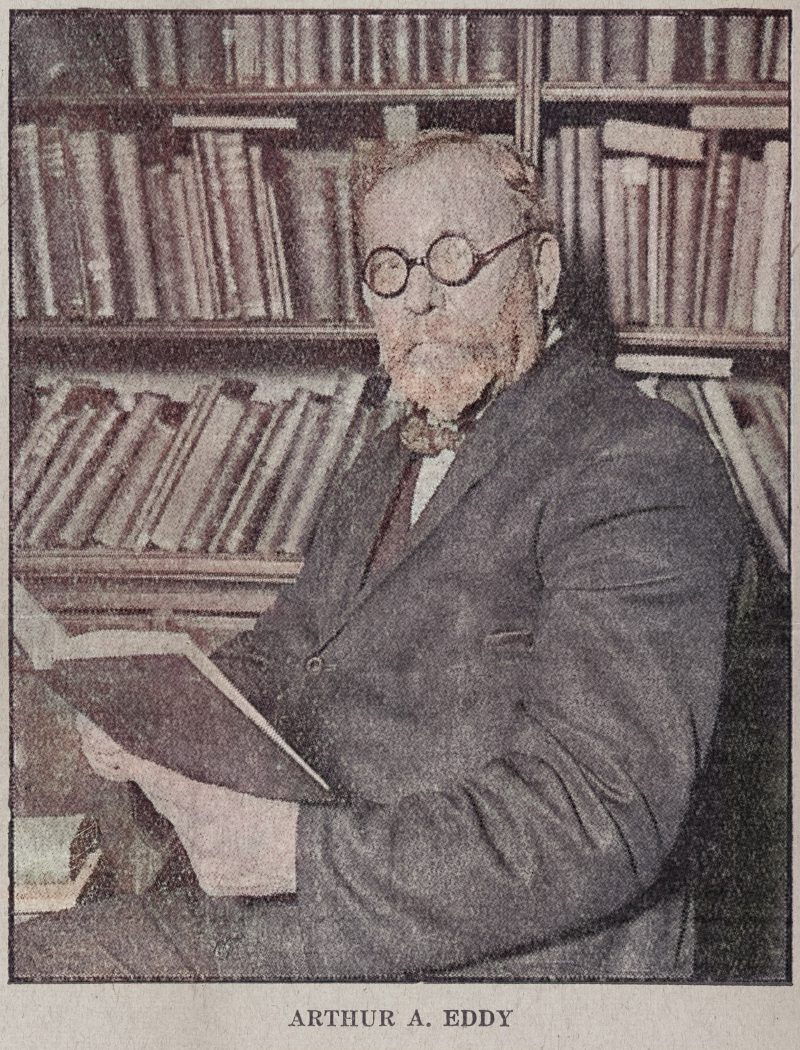This was H.P. Lovecraft’s Providence bookseller, the uncle of his sometime-friend and fellow-writer Eddy. Here I’ve de-screened from newsprint and colorised as best I can. Until someone comes up with a magic ‘AI newsprint de-screener’ this is as good as it gets, even from a big 600dpi scan.
This comes from the now-found ‘Uncle Eddy’ cutting I referred to some posts back. Evidently the ‘RIAMCO listing’ is actually for the Brown University holdings of Lovecraft, which are now online as hi-res scans along with their enclosures and cuttings. Good to know. Thus we now have a very good picture of Lovecraft’s favourite Providence book-dealer, albeit in dotty newsprint.
It’s from the Providence News-Tribune, 22nd July 1931. Lovecraft and the visiting Morton happened to pop in to the Eddy bookshop shortly after it had been published, and thus were presumably able to rush around and find some local news-stores that had not sent back their ‘returns’ copies of the paper. Copies were duly purchased and the clippings sent to correspondents who knew and had patronised Eddy.
What appears to be a Frankenstein-like scar on the right of his face seems to be his glasses-chain.
What do we learn from the article?
1) His shop was “probably the largest of its kind in the city” at 1931. A massive 200,000 volumes (and, as we know from Lovecraft, more in his attic store at home). Thus Lovecraft’s joking in a letter to the effect that ‘Cook had cleaned Eddy out’ on a spending spree, must refer to the weird and supernatural items only.
2) He looks as though he might be in his early 60s in 1931, although several scratches suggest the press used a picture dated earlier. Possibly came of age circa 1887-90? He had not yet retired at the point of publication. Indeed, he had taken on and recently sold the Bargain Book Shop on Empire Street, which suggest he was still very much in business and had money to invest in new stock.
3) Modern poetry was then “much in demand”, which would be unthinkable today when contemporary poets can only sell to other poets. “Modern” here may not necessarily mean modernist poetry, as this is Providence in 1931.
4) The article hints at his willingness to sell the sort of “paperback” items that would bring fulminating religious ministers into the store to berate him. He would stand up to them. Possibly the books were the Haldeman-Julius ‘Blue Books’ line.
5) He started the business as a side-line, though to what is not stated.
The final part of the article covers the city’s Dana bookstore, and another shop run by Livsey and Knight. This section has other detail on the state of the book trade in Providence during the early years of the Great Depression.



Great newspaper article on Arthur E. Eddy. Here are a few genealogy notes, for whatever they may add to the story.
Arthur Edwin Eddy was born in Providence on Oct. 31, 1860, the son of James Francis Eddy (1837-1919) and Lucy Hunt Tanner (1841-1893). He married Lillian Richards Bruce on Jan. 21, 1886 in Providence. Lillian was the daughter of John Richards Bruce (1834-1880) and Cynthia Buffington Gorton (1838-1925). Arthur and Lillian made their home at 100 Gallup Street in Providence, and had a son Harold Bruce Eddy (b. Feb. 8, 1890, d. Aug. 9, 1936), who became a music teacher.
Arthur worked as a jeweler until his fiftieth year (1910), when he became a bookshop proprietor. Arthur died on Apr. 13, 1933.
His younger brother Clifford Martin Eddy (1873-1937) was the father of HPL’s friend Clifford Martin Eddy, Jr. (1896-1967).
Thanks for that. I’ve slightly re-edited for narrative. You provide three useful points of data…
* 100 Gallup Street in Providence I’d found some years ago in Lower South Providence and it was close where were he started in the book trade. The house was visible some years ago but you prompted me to look again – it appears to have been torn down now, and the plot is between two other houses. Evidently no-one keeps it looking nice, not picking the trash on the verge and allowing big weeds to grow up on the plot.
* Jeweller until 1910. Interesting. So he’d made some good money at that, presumably, and then at age 50 decided to do ‘wind down’ a bit with a longer-term investment sideline. I imagine he could easily run the books alongside occasional tinkering with watch repairs and the like. But the books then became his main business and interest, perhaps related to eyesight problems which meant fine jewellery work was no longer an option? He appears to have quite thick glasses in the photo.
* Death date of Apr. 13, 1933. Again useful, as there are probably local obituaries to be found by those with access to the relevant databases and archives.